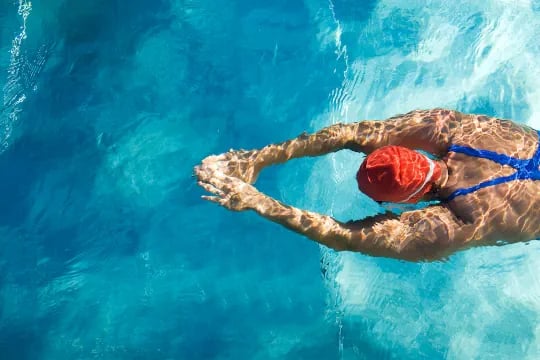Swimming
Why Swimming?
Swimming is one of those exercises that one can do without having to be particularly good at and feel the immediate benefits. Whether it is a leisurely 5-10 lengths at the local pool, or a faster paced hour of laps, the whole body feels the surge of endorphins.
Whilst swimming is not a weight bearing activity, which we know is optimum for improving bone density and muscle tone, it is ideal for those who’s joints are challenged by osteo arthritis or prefer low impact exercise. If you are already a regular swimmer you will know it works every part of the body. Shoulder feels stretched and mobilised, the core muscles are strengthened, the lower back, gluts and legs are all toned (a golden elixir for bodies that have sat at a desk all day).
A common musculo-skeletal issue that can arise when you start swimming is neck strain. Particularly in breaststroke if the head stays above the water line, the neck muscles work harder than usual in this position. Especially if the neck, shoulders and upper back muscles are tight already, the extra load will cause the muscles and neck joints to ache. Spending a few minutes stretching the neck and upper body muscles beforehand can help.

Alternating the swimming strokes you do will challenge the body further. Even one length of backstroke amongst a set of front crawl will strengthen the core muscles and shoulders even more than without. Drills are another good way to break up too much repetition and overloading particular joints. As is a waterproof device to monitor heart rate, lap times etc. Pull bouys and hand paddles are aides to increase water resistance and gradually improve strength.
Other common ailments among swimmers are rotator cuff tendonitis, shoulder impingement and lateral epicondylitis (tennis elbow) pain. These can be associated with a lack of flexibility in the neck and thoracic spine, and/or the upper extremity joints. Here at Haslemere Chiropractic clinic we use treatments to enhance joint mobility, spinal alignment and overall body function. This can help swimmers achieve a better range of motion leading to a better technique and improved performance in the water.
Treatment can also help reduce the risk of strains and sprains, and in the event of an injury, aid recovery faster, helping the swimmer return to the water more quickly.
Daniela is a keen swimmer, having been a Country swimmer as a teenager and now a member of the Haslemere Masters Swimming Club. She is happy to help with musculo-skeletal issues you may have to help improve your swimming.
